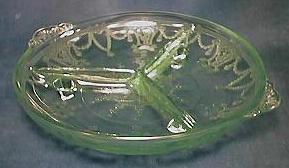
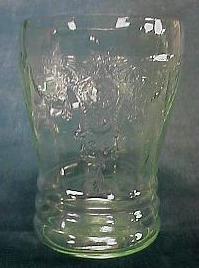
Cameo by Hocking Glass
Written by Rosemary Trietsch
A
woman came into my booth at a recent show and seemed to be deep in thought as
she looked everything over. When I asked if I could be of any help, she said she
was looking for a small piece of Depression glass to send to her friend in
Australia. It seems that, though she tried to explain what it is she’s
collecting, her friend couldn’t picture it, so she figured an example would
say it all. Then she asked me,
“Can you pick out a typical, representative piece of Depression glass for
me?” That is perhaps the hardest glass question I’ve ever been asked. I
mean, with so much variety, IS there such a thing as ‘typical Depression
glass’? I think the answer is really a matter of personal taste and
experience, but the first thing that popped into my head at the time was not a
single piece of glass, but a pattern: Cameo. With all the myriad of pieces
available – from the every day to the elegant - Cameo encompasses the entire
Depression glass spectrum.
Produced by Hocking from 1930 to 1934, Cameo really had its beginnings under a different name with another glass company. In the late 1920’s, Hocking acquired the Monongah Glass Company of Fairmont, West Virginia. The majority of Monongah’s molds were sent to Lancaster Glass, which had become a part of Hocking Glass in 1924. But Monongah’s ‘Springtime’ pattern seemed to be just what Hocking was looking for. They copied the pattern almost exactly and made new molds so that it could be machine pressed. (Springtime, as originated by Monongah, was pressed, etched, and gold trimmed all by hand.) In 1930, Cameo – a.k.a. ‘Ballerina’ for the figure in the cameo - became Hocking’s first mold etched dinnerware line and it remains one of the most popular Depression glass patterns ever made.


Most of the Cameo you find will be green, though the pattern was made in yellow, pink and crystal with platinum trim. Production of these last three colors was limited, with pink being the most expensive and hardest to find. If you come across any pink Cameo other than the 3-legged console bowl, consider yourself lucky. (If it’s priced less than $100, play the lottery immediately as you’re on a roll.) Crystal production was limited to a luncheon set and a cocktail set that includes the ice bowl, decanter, and a very rare cocktail shaker with a metal top. With its platinum trim, crystal Cameo looks very similar to Springtime, though Monongah’s glass quality is far superior. (Remember, you’re comparing machine pressed to hand finished glass.) Yellow was only made from 1932 to 1934. But it was sold in boxed sets that included the cup, saucer/sherbet plate, dinner plate, grill plate, and footed tumbler, making these pieces relatively common and inexpensive today. Unfortunately, Hocking didn’t include ‘Hostess sets’ with the place settings: the basic service may be cheap, but yellow serving pieces will require a home equity loan. (If you’ve ever seen a bunch of yellow Cameo together, you’ll agree that it’s well worth the interest rates. Hocking managed to capture pure sunshine in Cameo yellow – it’s a vibrant, wonderful color that glows on the table.)
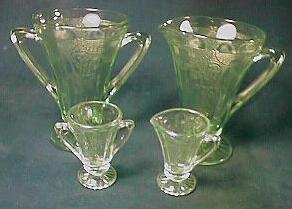
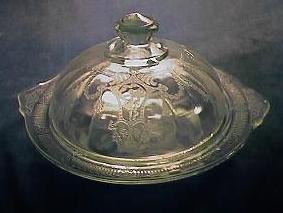
To
summarize: pink pieces are very scarce, yellow production was limited to a few
shapes, and crystal, though uncommon, really doesn’t attract much interest by
collectors. It’s green Cameo that
commands attention from today’s collectors – probably in the same way that
it captured Hocking’s creative energy back in 1930. In the four years that it
was produced, Hocking redesigned existing pieces and added entirely new items to
the Cameo line that they had not made before. Though many Cameo pieces are the
same shape as Block Optic - even having Block’s vertical panels along with the
ballerina design - the 3-part relish, cookie jar & lid, footed console bowl
and tall candlesticks, patterned decanter, and 8-inch vase were designed
specifically with the Cameo pattern in mind.
In fact, if you assembled one green piece in each of the shapes and sizes
made, you’d have over 70 different items.
With 10 different plates, 8 sizes of bowls, and 12 tumblers – footed, flat and stemmed – Cameo collections vary according to taste and wallet. Most common among the plates are the 6-inch sherbet, 8-inch luncheon, 9½-inch dinner, and 10-½ inch grill. Of course, if money is no object and you enjoy the hunt, you might choose the grill plate with closed handles, the 8 ½ inch square luncheon and the 10 ½ inch rimmed dinner plate (which looks like the handless grill plate without divisions. It also doubles as the flat cake plate.) This second place setting costs about $200 while the first runs around $40. The biggest choice you have in bowls will be to decide if you want flat soups at $65 each, cream soups at $150 each, or to skip soup in favor of an antipasto course. Tumblers pose the biggest problem for me personally, as the glass is wonderfully thin and delicate and I’d love to have full service in all 12 sizes. (Did you already figure out that I collect this pattern too?) Unless I’m very lucky hunting, the 3-½ oz wine goblet ($850 each) and 15 oz footed tumbler ($495 each) will not be coming to my house too soon.
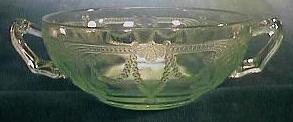
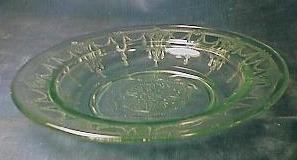
Once you’ve got your basic setting, it’s time to fill in the details. Sherbets come in 2 sizes: 3 1/8 inch or 4 7/8 inch. Cups can be had with a plain handle or a fancy handle – the fancy handle is the same scroll design that’s found on Block Optic cups. Whichever handle you choose, the sherbet plate doubles as the saucer. Hocking did make a very few saucers with an indented cup ring, but the odds are against finding even one – let alone enough for a set. Creamers and sugars also come in 2 sizes, with the 3 ¼ inch size having the fancy handle and the 4 ¼ inch having the plain handle. (Something I have noticed is that the pattern on the scroll handle cup is more distinct than that on the plain handle variety, and so I collect scroll cups. It also figures that I prefer the shape of the tall creamer and sugar that have the plain handles.) Of course, you can forgo the sugar bowl altogether and use the Domino tray instead. This is a 7 inch round tray with an indentation in the center to hold the creamer of your choice, while Domino sugar cubes go around the outside edge.
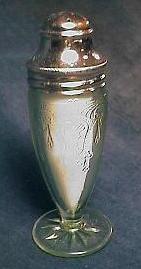
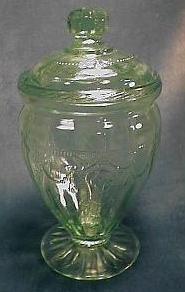
Well,
you’ve got the table set: now choose your serving pieces. Do you like round or
oval serving bowls and plates? Cameo has both. Next, you must decide if you
prefer the covered butter dish or an open butter tub. Either will cost over
$200, but the butter tub doubles as an ice bowl if you’re serving cocktails.
Do you need a 36 oz or 56 oz pitcher – with or without a roping design around
the upper edge? Perhaps the 20 oz milk pitcher or the 10-inch decanter and
stopper fit your needs better. The stopper confuses lots of folks because it
does not have the Cameo pattern on it: it’s the same geometric stopper
that’s found on another Hocking water bottle. Incidentally, Owens Illinois
Company probably ‘borrowed’ the decanter mold and used it to make vinegar
bottles in dark green as they’re found with the Owens mark. A cork, not a
glass stopper, was used in these vinegar bottles.
To round out your collection, Hocking provided many Cameo occasional pieces. There are 2 candy jars: a low one styled like the Block Optic candy jar, and a 6 ½ inch tall covered jar that was especially designed for the Cameo line. The base for the tall candy was modified to become the 5 3/4inch vase, so make note of the differences between the two: the candy jar bottom has roping around the edge, while the vase has a thinner lip that is flared. The covered jam jar is another addition Hocking made to the Cameo line. The bottom is sometimes confused with the ice bowl, which is 3 inches high and has handles that stick out from the side. (The jam jar bottom is 2 inches high and the handles stick up.) The console bowl and candlesticks are a set to rival any elegant pattern ever made. If Hocking was attempting to elevate its ‘every day glassware’ to ‘special occasion’ status, the console set does it. Add the 8-inch vase filled with lilacs, and you can’t ask for a more beautiful table. Finally, in the “Rarest of the Rare” category of Depression glass, you’ll find the Cameo center handled sandwich server. The last one I heard of for sale was snatched up for the meager price of $7700.
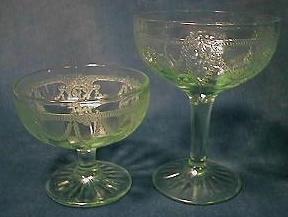
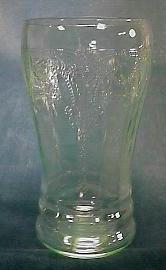
Remarkably,
Cameo collectors only have to watch out for one piece that’s been reproduced:
the salt/pepper shaker. New shakers are easy to recognize as they have a very
faint pattern and too much glass in the bottom. If you filled a repro shaker,
the salt would barely go halfway down. As you can see in the picture of my old
shaker, it’s filled to the base. In the 1980’s, Mosser glass made miniatures
of the Cameo line that some people confuse with older children’s sets, but as
Hocking never made Cameo children’s dishes, they’re not a problem for
collectors. The Mosser pieces are scale miniatures of actual Cameo pieces - more
like miniature doll furniture than reproductions meant to fool unsuspecting
collectors. Many folks (including yours truly) enjoy displaying the little sets
along with the real thing. It sort of adds another dimension to my glass
collection….
I
do have a collecting tip for folks starting a new pattern: buy the hard to find
pieces as soon as you see them as prices on rare things go up very quickly. In
the 8 years I’ve been collecting Cameo, I’ve been lucky to find the domino
tray, covered butter, tall sherbets, cream soup bowls, and all the covered
pieces. The prices I paid were what I considered reasonable at the time and much
less than they would sell for now. Of course my problem is that I have lovely
serving pieces but not enough plates to use them with. Ah, the trials and
tribulations of collecting Depression glass…..